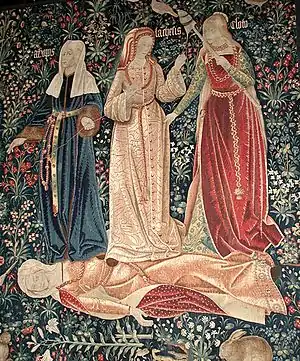Fates
The Fates were a common motif in European polytheism, most frequently represented as a group of three mythological goddesses (although their number differed in certain eras and cultures). They were often depicted as weavers of a tapestry on a loom, with the tapestry dictating the destinies of humans. According to Greek Mythology, the three Fates possess the loom. Only they, or another immortal, can alter it.
Historical occurrences
The primary instances include:
- Moirai[1][2][3] are the Fates of Greek mythology who control the Threads of Fate
- Parcae[4] are the Roman personifications of humankind's and the gods' destinies, commonly referred to as the Fates of Roman mythology. They are the Roman equivalents to the Greek Moirai. The names of the three Parcae are Nona (Greek equivalent Clotho), Decima (Greek equivalent Lachesis) and Morta (Greek equivalent Atropos). The earliest documents referencing the Parcae are three small stelae (stone or wooden slabs) found near ancient Lavinium.
- Deities and fairies of fate in Slavic mythology.[5] There are many Slavic deities and fairies who control or foretell a person's fate.
- Norns[6][7] are the Fates of Norse mythology, also related to other female deities in Germanic paganism
- Deivės Valdytojos,[8] seven goddesses who weave garments made from humans' lives in Baltic paganism
In fiction
This motif has been replicated in fictional accounts, such as:
- Three Witches, characters in Shakespeare's Macbeth[9]
- In his poem "Howl",[10] Allen Ginsberg warns of "the three old shrews of fate the one eyed shrew of the heterosexual dollar the one eyed shrew that winks out of the womb and the one eyed shrew that does nothing but sit on her ass and snip the intellectual golden threads of the craftsman's loom".
- Orddu, Orwen and Orgoch, characters in Lloyd Alexander's 1960s book series The Chronicles of Prydain.
- The Fates, characters in Disney's Hercules[11]
- The Fates/Moirai, characters in various books by Rick Riordan in the Percy Jackson and the Olympians, Heroes of Olympus and The Trials of Apollo series
- The Sisters of Fate, characters in the God of War video game series, based on the Greek Fates
- The Fates, characters in Anaïs Mitchell's Hadestown musical
- The Fates, primary antagonists of season five of the superhero television series Legends of Tomorrow
- The three aspects of Fate in the With a Tangled Skein ( Incarnations of Immortality, Book 3) series by Piers Anthony.
References
- Homer (1965–1967). The Iliad : with an English translation. W. Heinemann. OCLC 221448332.
- Bulfinch, Thomas (2016). Bulfinch's mythology. Digireads.com Publishing. ISBN 9781420953046. OCLC 1017567068.
- Homer (1938–1942). The Odyssey, with an English translation. W. Heinemann. OCLC 7440655.
- Day, John (1988). God's conflict with the dragon and the sea : echoes of a Canaanite myth in the Old Testament. Cambridge University Press. ISBN 0521256003. OCLC 1056600192.
- Cross, Tom Peete (July 1919). "Celtic MythologyThe Mythology of All Races, Vol. III. John Arnott MacCulloch , Jan Máchal , Louis Herbert Gray". The American Journal of Theology. 23 (3): 371–376. doi:10.1086/480029. ISSN 1550-3283.
- Goldenweiser, A. A.; Gray, Louis Herbert; Moore, George Foot; Fox, William Sherwood; Keith, A. Berriedale; Carnoy, Albert J.; Dixon, Roland B.; Alexander, Hartley Burr (1918-03-28). "The Mythology of All Races. Vol. I: Greek and Roman. Vol. VI: Indian and Iranian. Vol. IX: Oceanic. Vol. X: North American". The Journal of Philosophy, Psychology and Scientific Methods. 15 (7): 190. doi:10.2307/2940073. ISSN 0160-9335. JSTOR 2940073.
- Med, Intervju; Horverak, Øyvind (October 1995). "Article". Nordisk Alkoholtisdkrift (Nordic Alcohol Studies). 12 (5–6): 303–304. doi:10.1177/1455072595012005-616. ISSN 0789-6069.
- Klimka, Libertas (2012-03-01). "Senosios baltų mitologijos ir religijos likimas". Lituanistica. 58 (1). doi:10.6001/lituanistica.v58i1.2293. ISSN 0235-716X.
- Shakespeare, William (1623-01-01), "Macbeth", The Oxford Shakespeare: The Tragedy of Macbeth, Oxford University Press, pp. 91–92, doi:10.1093/oseo/instance.00000007, ISBN 9780198129011
- Ginsberg, Allen (2006). Howl. Museum of American Poetics Publications. OCLC 666904326.
- "Boogie Nights, 1997 (Movie Review and Trivia)", Appetite, University of Pittsburgh Press, 2012, p. 24, doi:10.2307/j.ctt1b3h9zv.18, ISBN 9780822978459
This article is issued from Wikipedia. The text is licensed under Creative Commons - Attribution - Sharealike. Additional terms may apply for the media files.
